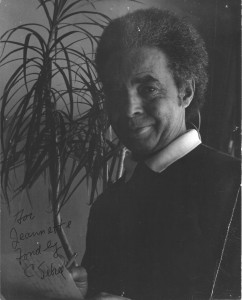Charles Sebree facts for kids
Quick facts for kids
Charles Sebree
|
|
|---|---|
 |
|
| Born | 1914 Madisonville, Kentucky
|
| Died | 1985 Washington, DC
|
| Nationality | American |
| Alma mater | Chicago Art Institute and the Chicago School of Design |
Charles Sebree (born 1914, died 1985) was an American artist. He was a painter and a writer for plays. He is famous for being part of Chicago's black arts scene. This was a lively time for artists in the 1930s and 1940s.
Early Life and Art Beginnings
Charles Sebree grew up in White City, Kentucky. In 1924, his mother moved to Chicago, Illinois. This move helped Sebree see many different kinds of art. When he was a young boy, one of his drawings was bought. The Renaissance Society paid twenty-five dollars for it. His drawing was even put on the cover of their magazine!
After high school, Sebree went to the Art Institute of Chicago. He stayed in Chicago and joined a group of artists. They were mostly in the South Side area of the city.
Art Career in Chicago
Chicago had a very active black arts movement. It was as exciting as the Harlem Renaissance in New York. Sebree met many artists there. Some of his friends were Margaret Taylor-Burroughs and Eldzier Cortor. He also got help from places like the South Side Community Arts Center. The Art Institute also supported him.
Sebree loved the theater very much. He wrote plays, directed them, and designed the sets. His paintings often showed performers. He especially liked painting harlequins and circus artists. His art shows a strong Modernist style. You can see how he was inspired by Picasso and Modigliani. Their paintings often had expressive faces and figures. Sebree also used ideas from Byzantine icons.
From 1936 to 1938, Sebree worked for the Works Progress Administration (WPA). This was a government program during the Great Depression. It helped artists find work.
World War II and New York
In 1942, Sebree's art career stopped for a short time. He was called to serve in World War II. He was sent to Camp Robert Smalls. This was a separate part of the Great Lakes Naval Training base. While there, he met a playwright named Owen Dodson. They became close friends and worked together on art projects. They created several plays at Camp Smalls. One play was called "Ballad of Dorrie Miller." It was about a black naval mess attendant. He saved many of his shipmates during the attack on Pearl Harbor.
After the war, Sebree moved to New York City. He found a new group of artist friends there. This was similar to what he had in Chicago. His friends in New York included famous people like Billie Holiday and Billy Strayhorn.
In 1945, Sebree received a special award. It was a fellowship from the Julius Rosenwald Fund. Later, he helped write a successful Broadway musical. It was called "Mrs. Patterson" and came out in 1954. The famous singer and actress Eartha Kitt starred in it.
Sebree moved to Washington, DC, in 1947. He lived there until he passed away in 1985.
Plays
- My Mother Came Crying Most Pitifully (1949)
- Mrs Patterson (1954)
- Dry August (1972)

